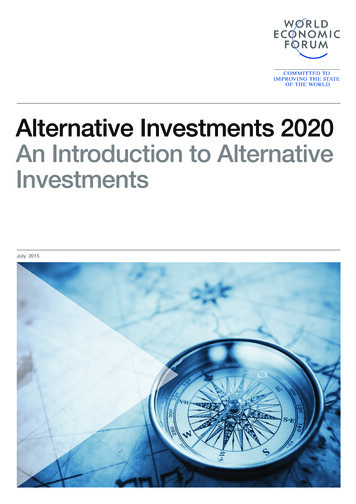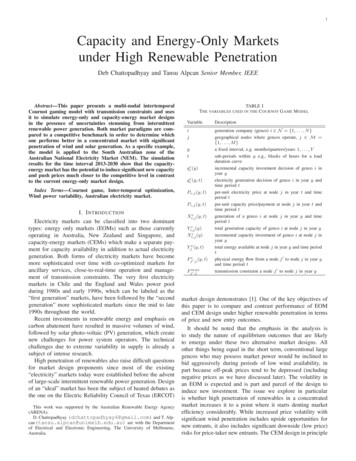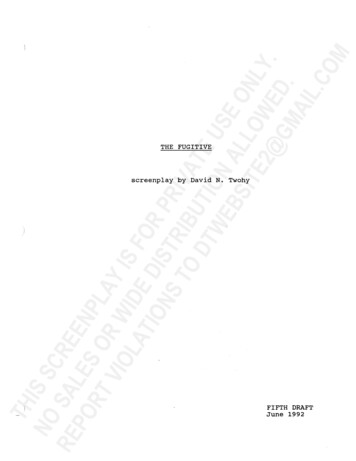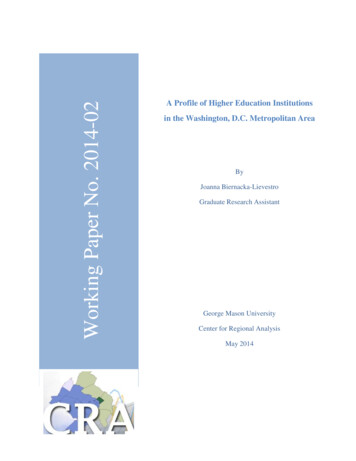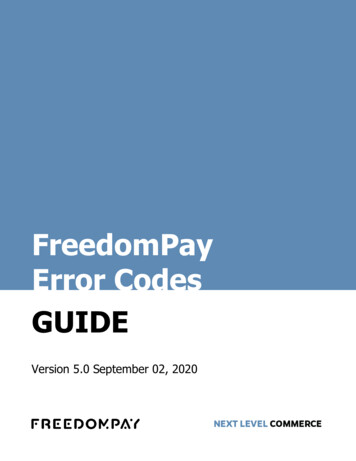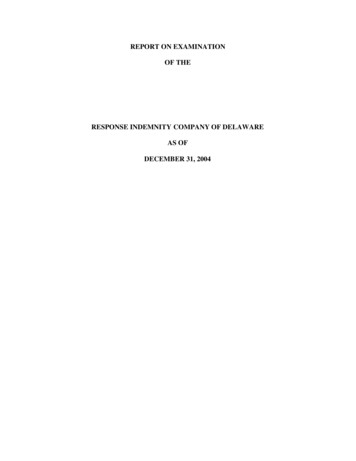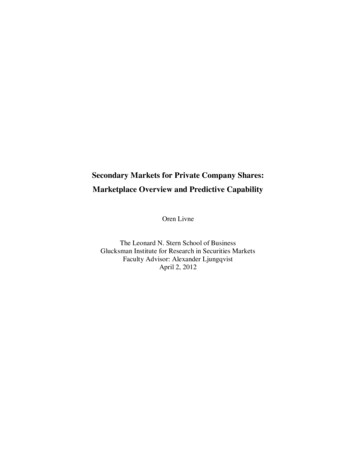
Transcription
Secondary Markets for Private Company Shares:Marketplace Overview and Predictive CapabilityOren LivneThe Leonard N. Stern School of BusinessGlucksman Institute for Research in Securities MarketsFaculty Advisor: Alexander LjungqvistApril 2, 2012
I.INTRODUCTIONThe marketplace for private company shares has evolved rapidly over the last few yearsin response to changing market dynamics and increasing interest in the next generation of largeInternet-based companies. This paper provides an overview of the evolution of the privatecompany secondary marketplace in the United States, its current players, and the risks andbenefits to those involved. The paper then discusses several companies that have transitionedfrom secondary market transactions to initial public offerings (IPOs). Finally, this paperevaluates the ability of secondary market data to predict share price changes post IPO.II.EVOLUTION OF THE MARKETPLACEA wave of companies is vying for a role in the secondary marketplace for privatecompany shares. Until recently, trading platforms were limited to institutional buyers and mosttransactions were conducted largely on an ad-hoc basis.1 Secondary interests in private companyshares could be acquired through investment funds or on an individual basis. 2 Shares could bepurchased directly from founders, employees, angel investors or general partners of older vintageventure capital funds seeking liquidity. 3 Alternatively, shares could be acquired indirectly, forexample, in the form of limited partnership interests. 41Jose Miguel Mendoza and Erik P. M. Vermeulen, The 'New' Venture Capital Cycle (Part I): The Importance ofPrivate Secondary Market Liquidity, Lex Research Topics in Corporate Law & Economics Working Paper No. 1/2011(May 3, 2011). Available at: http://ssrn.com/abstract 1829835.2Id.3Hans Swildens, Venture Capital Secondary Funds – The Third Exit Option: A smart way to improve fundperformance and unlock hidden value, Industry Ventures LLC White Paper (May 2008). Available at:http://www.industryventures.com/pdf/Venture Capital Secondaries White Paper.pdf.4Id.1
In 1990, Nasdaq launched PORTAL (Private Offerings, Resales, and Trading throughAutomated Linkages) as a private institutional marketplace for 144A securities. 5 144A is a safeharbor that provides qualified institutional buyers with an exemption from the registrationrequirements of Section 5 of the Securities Act. 6 A web-based version of PORTAL wasapproved by the SEC on July 31, 2007 and began operating on August 15, 2007.7,8 At roughlythe same time, several investment banks launched their own trading systems. Goldman Sachslaunched its GSTrUE (Tradable Unregistered Equity) system in May, 2007. 9,10 A group of fiveWall Street firms (Citigroup, Bank of New York Mellon, Lehman Brothers, Merrill Lynch, andMorgan Stanley) formed OPUS-5 (Open Platform for Unregistered Securities) in August 2007and were later joined by Bank of America, Credit Suisse, and UBS. 11 Several other firms,including JPMorgan Chase and Bear Sterns, launched their own platforms. 12In November 2007, Nasdaq and twelve Wall Street firms announced the PortalAlliance. 13,14 The alliance formed to merge several different 144A platforms (including5Self-Regulatory Organizations; The NASDAQ Stock Market LLC; Notice of Filing and Immediate Effectiveness of aProposed Rule Change to Eliminate Rules Related to Nasdaq’s PORTAL Market, Securities and ExchangeCommission (Release No. 34-60991; File No. SR-NASDAQ-2009-092) (November 12, 2009). Available 91.pdf.617 C.F.R. § 230.144A (2012).7Order Granting The NASDAQ Stock Market LLC’s Application for an Exemption Pursuant to Section 36 of theSecurities Exchange Act of 1934, Securities and Exchange Commission (Release No. 34-56176) (July 31, 2007).Available at: f.8NASDAQ's Electronic Trading Platform for the 144A Private Placement Market is Approved by the SEC: ThePORTAL Market Trading System Will Begin Operating On August 15, The Nasdaq Stock Market, Inc. Press Release(August 1, 2007). Available at: D 257543.9Arleen Jacobius, Slow start, great hope for Nasdaq private exchange: Pensions & Investments, SecondMarket(January 14, 2010). Available at: y Zuckerman, A Hot Idea Falls Short at Goldman, WSJ.com (April 7, 2011). Available 04587004576245101094450490.html.11Elena Schwieger, Comment, Redefining the Private Placement Market After Sarbanes-Oxley: Nasdaq'sPortal and Rule 144A, 57 Cath. U. L. Rev. 885 (2008).12Id.13About the PORTAL Alliance, Available at: http://www.portalalliancemarket.com/about pa content.aspx.14Anupreeta Das, Nasdaq, Wall St Firms Join Forces for 144a Market, Reuters (November 12, 2007). Available e012-n12453209-oisbn-idUSN1245320920071112. The initial2
GsTRUE and OPUS-5).15 The financial difficulties of several of the firms involved, includingLehman Brothers and Bear Sterns, delayed the launch until September 2009 when nine banksagreed to list 144A or private company transactions. 16Another marketplace, NYPPEX, has been active in the secondary private markets since1998.17 According to the firm, they are “one of the world's leading private equity secondaryintermediaries for single interest transactions having a minimum size of 100,000 up to 10million [and] help founders, key employees and individual investors achieve superiortransaction speed and price execution, with minimal market impact.” 18 The investment bankFriedman Billings Ramsey also entered the 144A transaction space in 1997 and, according to thefirm, “has since been the dominant firm in the Rule 144A equity market. In the last ten years, thefirm has completed nearly 10 times as many 144A transactions and raised nearly 10 times asmuch capital via these transactions as any other investment bank.” 19While the 144A market has been successful in supporting larger transactions, the focuson institutional investors resulted in very limited acceptance for smaller offerings, includingthose of venture-backed companies.20,21,22 Grant Thorton hypothesizes that the absence oftwelve firms were: Bank of America, Bear Stearns, Citigroup, Credit Suisse, Deutsche Bank, Goldman Sachs,JPMorgan, Lehman Brothers, Merrill Lynch, Morgan Stanley, UBS, and Wachovia.15Id.16Arleen Jacobius, Slow start, great hope for Nasdaq private exchange: Pensions & Investments, SecondMarket(January 14, 2010) (The nine firms were: Bank of America, Merrill Lynch, Credit Suisse Group, Deutsche Bank AG,Citigroup Inc., Goldman Sachs Group Inc., JP Morgan Chase & Co., Morgan Stanley, UBS AG, and Wells FargoSecurities LLC). Available at: art-great-hope-for-nasdaqprivate-exchange.17Our Company, NYPPEX Private Markets, http://nyppex.com/company.php (2011).18Brokerage, NYPPEX Private Markets, http://nyppex.com (2011).19Our History, FBR & Co, en Jacobius, Slow start, great hope for Nasdaq private exchange: Pensions & Investments, SecondMarket(January 14, 2010). Available at: y Zuckerman, A Hot Idea Falls Short at Goldman, WSJ.com (April 7, 2011). Available 04587004576245101094450490.html.22Jay R. Ritter, Equilibrium in the IPO Market (April 25, 2011). Available at: http://ssrn.com/abstract 1822542.3
“individual investors from the market is likely to undercut its ability to support small offerings,because large populations of small (retail) investors are what historically support liquidity andvaluations in small cap stocks.”23III.CURRENT PLAYERSThe traditional ad-hoc methods discussed in Section I continue to be the primarymechanism for transacting in private company shares. 24 The ecosystem has broadened to includeseveral additional avenues for the players involved. Secondary funds, exchange funds,secondary marketplaces, financial firm platforms, and Nasdaq-listed companies that provideindirect access to private company securities are discussed below.a. Secondary FundsThere are several active secondary funds, including those managed by Industry Ventures,Millennium Technology Value Partners, Saints Capital, and W Capital Partners. 25 IndustryVentures was founded in 2000 and has secondary funds that invest in venture-backed companyshares by purchasing shares directly from founders, employees, investors, and general partners orby acquiring limited partnership interests.26,27 Investments have included interests in Pandora,23David Weild and Edward Kim, Why are IPOs in the ICU?, Grant Thornton White Paper. Available %20the%20ICU 11 19.pdf.24Chris Kelley, Panel – Private Company Stock Market – Friend or Foe?, SecondMarket Capitalyze 2011 Conference,San Francisco. (May 11, 2011). Video available at: 5Darian M. Ibrahim, The New Exit in Venture Capital, University of Wisconsin Legal Studies Research Paper No.1137 (October 7, 2010). Available at: http://ssrn.com/abstract 1688982.26Focusing on Inefficiencies in Venture Capital, Industry Ventures, rs, Management & Early Investors, Industry Ventures, http://www.industryventures.com/founders earlyinvestors.html.4
Facebook, and Twitter.28 In July 2011, Industry Ventures closed its sixth secondary fund ( 400million).Millennium Technology Value Partners develops alternative liquidity programs inpartnership with venture-backed companies. 29,30 It launched its current strategy in 2002 andclosed its most recent fund ( 280 million) in April 2010.31,32 Investments have been made inover 300 companies including Facebook, Twitter, and Zappos. 33 Saints Capital launched in 2000and provides liquidity for private company investors through customized transactions. 34 SaintsCapital has invested in high-growth industries such as software, internet, healthcare and businessservices. 35 W Capital Partners was formed in 2001 and provides secondary liquidity in severalcategories including growth and venture capital. 36, 37 Investments include Internet,communications and infrastructure, life sciences, and software and services companies. 38b. Exchange clubsSeveral creative alternatives have developed to satisfy the need for liquidity in smallersecondary offerings. In December 2009 in London and October 2010 in the United States, theFounders Club was launched to allow company founders to swap part of their future income28Sam Sutton, Industry Ventures raises 400m for secondaries: The San Francisco secondaries firm exceeded itssixth fund’s 300m target by attracting new LPs and re-ups, Private Equity International (July 11, 2011).Available at: 9Overview, Millennium Technology Value Partners, http://mtvlp.com/overview (2012).30Dan Burstein, Panel - Secondary Transaction Mechanics and Primer, SecondMarket Capitalyze 2012 Conference,New York (February 15, 2012). Video available at: capitalyze-east.31Millennium Technology Value Partners, CrunchBase, llennium-technology-ventures.32Millennium Technology Value Partners II, L.P. Closes on 280 Million for New Fund, Millennium Technology ValuePartners Selected Highlights of Media Coverage, 02010%20Press%20Release.pdf (April 2010).33Overview, Millennium Technology Value Partners, http://mtvlp.com/overview (2012).34Overview, Saints VC, http://www.saintsvc.com/about/overview (2012).35Id.36W Capital Partners, http://wcapgroup.com (2011).37All Investments, W Capital Partners, efault.aspx (2011).38Id.5
streams for ownership in the fund and the potential for more immediate liquidity than theirindividual companies could provide.39,40 Entrex’s “TIGRcub ” structure offers a similarservice that provides “Investors with monthly income, liquidity and investment returns that arenot based on exit events, or exposed to the volatility of the equity capital markets—all whileproviding Issuers a non-dilutive capital solution with risk-adjusted pricing simulating either debtor equity structures.”41c. Marketplacesi. SecondMarketSecondMarket, which initially provided a liquidity solution for restricted securities inpublic companies, began transacting in private company shares in 2008 and launched its privatecompany marketplace in mid-2009. 42 The popularity of Facebook and its early presence in themarketplace has created significant positive publicity for SecondMarket. 43 SecondMarketcompleted 558 million in private company transactions in 2011 (a 55% increase from theprevious year) and over 1 billion since 2008.44 Nearly 15,000 accredited investors are on theplatform with over 6 billion in indications of interest in 2011. 45SecondMarket earns a fee of at least 2,500 for each completed transaction. The fee is“determined on a case-by-case basis depending on many factors, including, but not limited, to39About The Founders Club, The Founders Club, tml.Sell Shares for Cash, The Founders Club, ell-shares-for-cashdirect-secondaries.html.41About Us, Entrex, http://www.entrex.net/about us.shtml.42Company Overview, SecondMarket Holdings Inc., https://www.secondmarket.com/about-us?t fl (2012).43According to M. Adam Oliveri, Managing Director – Private Company Market, SecondMarket, as of February 15,2012, Facebook continued to generate the largest volume of transactions on SecondMarket. M. Adam Oliveri,Panel - The Secondary Market Big Picturer, SecondMarket Capitalyze 2012 Conference, New York (February 15,2012). Video available at: -capitalyze-east.44SecondMarket’s 2011 Year End Private Company Report, SecondMarket Holdings Inc. (January 19, 2012).Available at: .406
the asset type, value of the asset, and complexity of the transaction.”46,47 The minimumtransaction size is 100,000, which SecondMarket feels is necessary to justify the fixed costsinvolved.48 In addition to SecondMarket’s commission, transaction costs include an opinionletter of the seller’s counsel that the private placement exemption from registration applies( 2,500 for small transactions, more for larger) and potentially transfer fees required by thecompany to cover the administrative costs of transferring shares from seller to buyer. 49Initially, SecondMarket did not require the consent of the issuer, but their model hasevolved. Now SecondMarket designs “customized liquidity program[s]” for the company andconsiders the company as their customer.50,51 Companies are allowed to determine how themarketplace for their shares is structured. The companies decide who may sell to whom (e.g., onlyformer employees to existing shareholders), the number of shares that can be sold, the transactionfrequency (e.g., weekly, or, in most cases quarterly or annually), and the pricing structure (e.g., anegotiated one-off transaction vs. auction).52 Each company is audited and required to providefinancial information to eligible buyers and sellers through a secure data room.5346SecondMarket Admin, How does SecondMarket make money?, SecondMarket Holdings 8-how-does-secondmarket-make-money (December 06, 2010).47SecondMarket Admin, Is there a minimum transaction size for buying securities through -buying-securitiesthrough-secondmarket (December 06, 2010).48Id.49Id.50Jeremy Smith, Presentation – A Deep Dive into Secondary Market Mechanics, SecondMarket Capitalyze 2011Conference, San Francisco. (May 11, 2011). Video available e.51Tom Johansmeyer, The Differences Between SecondMarket and SharesPost According to Their CEOs, BusinessInsider (December 1, 2011). Available at: -ceos-2011-12.52The Future of Capital Formation: Hearing Before the House Committee on Government and Oversight Reform,112th Congress (May 10, 2011) (statement of Barry Silbert, CEO, SecondMarket). Available mony/5-10-11 Barry Silbert Capital Formation Testimony.pdf.53The Future of Capital Formation: Hearing Before the House Committee on Government and Oversight Reform,112th Congress (May 10, 2011) (statement of Mary Schapiro, Chairman, Securities and Exchange Commission).7
Consumer web and social media transactions dominate on SecondMarket, making up61.4% of transactions in 2011. 54 Figure 1 provides a detailed breakdown of the 2011transactions by industry. A typical company on the platform has at least 20 million in revenueand a market capitalization of 100 million, is four or more years old, has received at least SeriesB funding, and has more than fifty shareholders. 55Figure 156Available at: y/5-1011 Schapiro Capital Formation Testimony.pdf54SecondMarket’s 2011 Year End Private Company Report, SecondMarket Holdings Inc. (January 19, 2012).Available at: mie Hutchinson, Panel - Secondary Transaction Mechanics and Primer, SecondMarket Capitalyze 2012Conference, New York (February 15, 2012). Video available at: capitalyze-east.56SecondMarket’s 2011 Year End Private Company Report, SecondMarket Holdings Inc. (January 19, 2012).Available at: ndmarkets-2011-year-end-private-companyreport.8
Institutional buyers were parties in 72.8% of the 558 million in transactions. Figure 2 providesa more detailed breakdown on the type of institutional buyers on SecondMarket.Figure 257A large majority of sellers in 2011 were ex-employees (79.3% by dollar value). Employees(11.1%), investors (3.7%), founders (0.4%), and others (5.5%) make up the remainder. 58In March 2011, SecondMarket launched a “watching” feature to provide investors with away of tracking companies of interest.59 As of January 26, 2012, there were 18,716 companiesavailable for watching on SecondMarket; however, fewer than a third (6,011) had one or morewatchers.60 As illustrated in Figure 3, the majority of companies have relatively few watchers.57Id.Id.59Id.60Search Companies, SecondMarket Holdings Inc., h.589
SecondMarket Watchers(as of January 26, 2012)Number of s400050006000Figure 361The top ten companies watched as of January 26, 2012 were Facebook (13,296 watchers),Twitter (7,254), Foursquare (3,722), Dropbox (3,534), Yelp (2,929), Gilt Group (2,310), Hulu(2,258), Square (2,229), LivingSocial (2,178), and Craigslist (1,962). 62ii. SharesPostSharesPost was founded in early 2009 and, per the company, connects over 86,000institutional and individual investors with over 1 billion worth of private company shares. 63SharesPost is focused exclusively on private company transactions (SecondMarket, on the otherhand, handles several categories of illiquid assets). As of November 2011, SharesPost washandling four trades per day and had completed transactions for forty different companies in2011.6461Data from Search Companies, SecondMarket Holdings Inc., .62Id.63About Us, SharesPost Inc., https://www.sharespost.com/pages/about.64Interview - Weir Sees Explosive' Growth in Secondary Markets, The Washington Post (November 9, 2011). Videoavailable at: AjDnt6M video.html.10
SharesPost uses FINRA-registered specialists to assist in consummating transactions.The specialists charge a 3% commission on the transaction value (minimum of 5,000). 65 U.S.Bank is available as escrow agent and charges 1,500 to both buyer and seller for eachtransaction. 66 The minimum sales price on SharesPost is 25,000.67 Companies traded onSharesPost are usually valued at 100 million or more, have at least 10 million in revenue, andwere founded at least 5 years ago.68Unlike SecondMarket, SharesPost does not require the involvement of the companywhose shares are transacted. Companies that choose to be involved are able to control who buys(e.g. only institutional buyers or certain individuals) and who sells, when transactions occur, andunder what terms. 69SharesPost does not provide reports summarizing the types of companies transacted on itsplatform. However, based on the data that is provided, SharesPost hosts a large number ofcleantech/energy transactions. On January 26, 2012, there were 23 companies with buy or selloffers available on SharesPost. SharesPost categorizes the companies as cleantech/energy (5listed), consumer (3), software (3), enterprise (2), retail (2), web (2), financial services (2), social(2), advertising & marketing (1), biotech (1), healthcare (0), media & online content (0), andtelecom/hardware (0). Facebook is the most commonly traded company on SharesPost. Therehave been over 200 Facebook transactions since August 20, 2009.70In addition to providing transaction data via its website and Bloomberg terminals,SharesPost has made efforts to provide additional information and transparency through its65Sellers FAQs, SharesPost Inc., .69Sharespost Private Investor Portals, SharesPost Inc., 2012).70Data was gathered from SharesPost.com and Bloomberg.6611
“SharesPost Venture-Backed Index” and research reports. The index aggregates transactiondata, current posts on the marketplace, and research-based valuation estimates for sevencompanies.71 The index provides some basis for determining trends in the secondarymarketplace for private company shares. SharesPost also makes available a large number ofresearch reports, which typically include an overview of the company’s products, markets, andcompetitors, financial information, forecasts, and valuations. 72 These reports are designed toassist buyers and sellers with their investment decisions (with disclaimers). However, questionshave been raised regarding the independence of these reports.73 Significant potential issuesremain with the level of information provided on all the secondary markets.iii. Xpert FinancialXpert Financial was founded in early 2009 with the support of well-known venturecapitalist Tim Draper, who is chairman of the company’s board.74,75 Xpert Financial has notdisclosed information on its transactions to the extent of SharesPost or SecondMarket and moretightly controls login access to its site (which is limited to shareholders, companies, accreditedinvestors, and qualified institutional buyers). 76,77Xpert Financial uses a registered broker-dealer subsidiary, Xpert Securities, to provide anonline trading platform called Xpert ATS for transacting in private company shares. 78 Theplatform supports both primary offerings and secondary trading. Shares are sold through either a71As of March 13, 2012, the index companies are Bloom Energy, Eharmony, Facebook, Gilt Groupe, Linden Lab,Serious Energy, and Twitter.72Research, SharesPost Inc., https://www.sharespost.com/research.73Usha Rodrigues, Who's Buying on SharesPost? Who's Selling? Reply Hazy, Try Again, The Conglomerate (January6, 2012). Available at: -on-sharespost-we-dontknow.html.74Xpert Financial, CrunchBase, 75Leadership, Xpert Financial, ml.76Register for an Account, Xpert Securities Inc., https://www.xpertsecurities.com/apply.77Matt Bowman, Interview - Tim Draper unveils the XChange Marketplace, Vator News (June 1, 2009). Videoavailable at: condary-markets.78About Us, Xpert Financial Inc., https://www.xpertfinancial.com/about/about us.html.12
fixed-price offering or a modified Dutch auction.79 Xpert Financial indicates that by using its“auto-execution technology”, transactions can settle and clear in days rather than the weeks ormonths previously necessary. 80 Companies are given control over the market for their shares,including who can sell and who can buy. 81 However, according to a February 3, 2012 WallStreet Journal article, Xpert Financial may have shifted its focus away from secondarytransactions and towards primary. 82 A subsequent Xpert Financial press release appears to haveconfirmed this shift; all of the examples of companies using its platform focused on primarycapital raises (with exception of one that included a purchase from an existing rights holder inconjunction with a primary raise). 83d. Recent EntrantsIn 2011, several firms announced their plans to provide platforms for trading privatecompany shares. These efforts are likely in response to the success demonstrated bySecondMarket and SharesPost. However, unlike SecondMarket and SharesPost, most of thesenew entrants are focused solely on institutional investors (with the exception of WedbushSecurities and Gate Technologies, which also service accredited individuals).In February 2011, Gate Technologies announced the purchase of InfoExchange as ameans for providing improved investment research to customers and an aid in its competition79Xpert Private Offerings, Xpert Financial, https://www.xpertfinancial.com/products/products xpo.html.Private Market Share Transactions Radically Streamlined, Press Release, Xpert Financial Inc. (April 29, 2011).Available at: https://www.xpertfinancial.com/about/press release/auto execute.html.81Xpert Financial Announces Fully-Electronic Alternative Trading System for Private Company Securities, PressRelease, Xpert Financial Inc. (January 3, 2011). Available at:https://www.xpertfinancial.com/about/press release/first sec registered ats.html.82Rolfe Winkler, Facebook's Painful Secondary Impact, WSJ Online (February 3, 2012). Available 04662204577199220078140972.html.83Xpert Financial Sees Growing Interest In Its Secondary Trading Platform, PEHUB citing Xpert Financial PressRelease, March 9, 2012).8013
with SecondMarket and Sharespost.84 Gate Technologies hoped to centralize transactionsthrough its electronic platform. However, a recent Wall Street Journal article indicates thecompany has had difficulty gaining traction. 85,86 Also in February, Mission Markets, a socialimpact investment firm, announced its first secondary offering of private company stock. 87In October 2011, Cantor Fitzgerald, a financial services firm, announced that it wasforming the Cantor Private Markets Group to offer clients the opportunity to invest in privatecompany stock (as well as REITs and private equity and hedge fund interests). 88 Liquidnet, aglobal institutional trading network, also announced in October 2011 that it was entering “thefast-growing market in private-company shares trading.” 89 Liquidnet indicated that it will focuson large institutional investors seeking access to high-growth companies and will work directlywith private companies to establish liquidity programs. 90 However, the executive hired to runLiquidnet’s private company program resigned after just three months raising questions about thestatus of their program.9184Nina Mehta and Jeff Kearns, Gate Buys InfoEx as Private-Trading Rivalry Grows, Bloomberg (February 7, 2011).Available at: tml.85Id.86Rolfe Winkler, Facebook's Painful Secondary Impact, WSJ Online (February 3, 2012). Available 04662204577199220078140972.html.87Mission Markets First to Facilitate Secondary Liquidity for Impact Investing Markets, Business Wire (February 15,2011). Available at: y-Impact-Investing.88Cantor Fitzgerald & Co. Announces the Expansion of Its Private Securities Business with the Formation of CantorPrivate Markets, Press Release, Cantor Fitzgerald & Co. (October 6, 2011). Available at:http://www.cantor.com/press releases/Cantor Fitzgerald Co Announces the Expansion of Its Private Securities Business with the Formation of Cantor Private Markets .html.89Liquidnet Launches Global Institutional Platform for Fast Growing Private-Company Shares Trading, PressRelease, Liquidnet Holdings Inc. (October 17, 2011). Available .91Ari Levy and Chris Dolmetsch, Lou Kerner Departs Liquidnet After Three Months on the Job, BusinessWeek(January 24, 2012). Available at: b.htm
Wall Street firms (Citigroup, Bank of New York Mellon, Lehman Brothers, Merrill Lynch, and Morgan Stanley) formed OPUS-5 (Open Platform for Unregistered Securities) in August 2007 and were later joined by Bank of America, Credit Suisse, and UBS.11 Several other firms, including JPMorg





